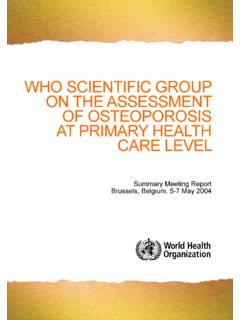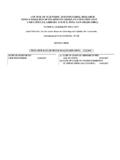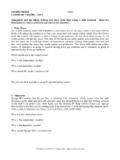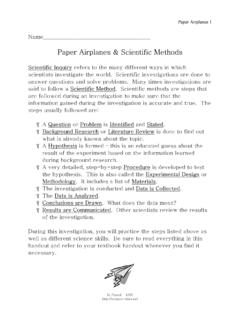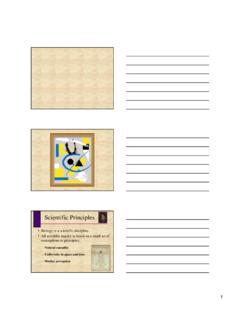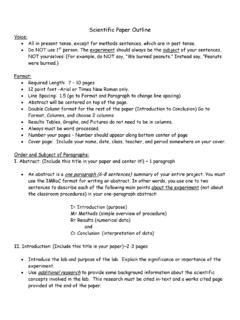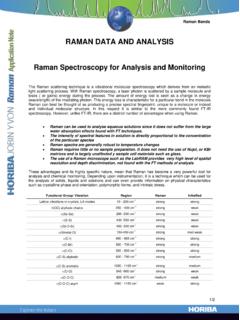Transcription of THE SCIENTIFIC BASIS OF TOBACCO PRODUCT …
1 This report contains the collective views of an international group of experts anddoes not necessarily represent the decisions or the stated policy of the World Health OrganizationWHO Technical Report Series945 THE SCIENTIFIC BASIS OFTOBACCO PRODUCTREGULATIONR eport of a WHO Study group 978-92-4-120945-8_FM_iWHO Library Cataloguing-in-Publication DataThe SCIENTIFIC BASIS of TOBACCO PRODUCT regulation : report of a WHO study group .(WHO technical report series ; no. 945) - adverse effects. industry - legislation. use disorder. HealthOrganization. TOBACCO Free Initiative. 978 92 4 120945 8 (NLM classification: QV 137)ISSN 0512-3054 World Health Organization 2007 All rights reserved. Publications of the World Health Organization can be obtained from WHO Press,World Health Organization, 20 Avenue Appia, 1211 Geneva 27, Switzerland (tel.)
2 : +41 22 791 3264; fax:+41 22 791 4857; e-mail: Requests for permission to reproduce or translate WHOpublications whether for sale or for noncommercial distribution should be addressed to WHO Press,at the above address (fax: +41 22 791 4806; e-mail: designations employed and the presentation of the material in this publication do not imply theexpression of any opinion whatsoever on the part of the World Health Organization concerning the legalstatus of any country, territory, city or area or of its authorities, or concerning the delimitation of its frontiersor boundaries. Dotted lines on maps represent approximate border lines for which there may not yet befull mention of specific companies or of certain manufacturers products does not imply that they areendorsed or recommended by the World Health Organization in preference to others of a similar naturethat are not mentioned.)
3 Errors and omissions excepted, the names of proprietary products aredistinguished by initial capital reasonable precautions have been taken by the World Health Organization to verify the informationcontained in this publication. However, the published material is being distributed without warranty of anykind, either expressed or implied. The responsibility for the interpretation and use of the material lies withthe reader. In no event shall the World Health Organization be liable for damages arising from its publication contains the collective views of an international group of experts and does not necessarilyrepresent the decisions or the stated policy of the World Health in IndiaPrinted in Background References and design features of TOBACCO products.
4 Theirrelationship to dependence potential and consumer Background Terminology Relationship between dependence potential and Effect of contents and designs on dependence potential dose level Modifying nicotine delivery speed and efficiency by pHand free nicotine Regulatory implications and Personal and local vendor-made products levels Assessing and regulating dependence Conclusions Research Regulatory recommendations TOBACCO products: research needs andregulatory recommendations Purpose of the recommendations Background Description of flavoured TOBACCO Flavoured brands Flavour Regional and global patterns of flavoured TOBACCO PRODUCT use Impact on public Science base and Research Regulatory of TOBACCO exposure and of TOBACCO smoke-inducedhealth Background Biomarkers.
5 Definition and Measuring Measuring injury and Existing evidence on biomarkers Specific TOBACCO alkaloids TOBACCO alkaloids particulate phase components Gas phase components DNA and protein adducts activity of the urine Measuring biological Assessing oxidative stress Measures of inflammation Measures of endothelial dysfunction Measures of clotting Insulin resistance Circulating endothelial precursor cells Femoral and internal carotid artery Sister chromatid exchanges in peripheral lymphocytes Summary of existing biomarkers Recommended uses for biomarkers of exposure and effect Improving the accuracy of the definition of currenttobacco use status Evaluating the intensity of exposure to Evaluating the intensity of exposure as a proxy for totaltobacco exposure Measuring reduced injury or harm Summary of biomarker recommendations References maximum limits for toxic constituents in cigarette smoke Introduction Regulatory strategy Selection of the machine-testing method Criteria for selecting constituents for regulating maximum Specific regulatory recommendations for TSNAs Interpretation of the maximum limit values Communication of the results of the testing to the Methods for measuring nitrosamines Considerations for modified cigarettes and potential reducedexposure Future directions References Contents and design features of TOBACCO
6 Products: theirrelationship to dependence potential and consumer Candy-flavoured TOBACCO products: research needs andregulatory recommendations Biomarkers of TOBACCO exposure and of TOBACCO smoke-induced health Setting maximum limits for toxic constituents in cigarettesmokeAcknowledgements Annex 1 Reports and other documents arising from meetings of the WHOS cientific Advisory Committee on TOBACCO PRODUCT Regulation(SACTob) Statement of principles guiding the evaluation of new ormodified TOBACCO products (2003) Recommendation on nicotine and its regulation in TOBACCO andnon- TOBACCO products (2002) Recommendation on TOBACCO PRODUCT ingredients andemissions (2003)SACTob recommendations on health claims derived fromISO/FTC method to measure cigarette yield (2003)Recommendation on smokeless TOBACCO products (2003)
7 Annex 2 Reports and other documents arising from meetings of the WHOS tudy group on TOBACCO PRODUCT Regulation (TobReg) Guiding principles for the development of TOBACCO productresearch and testing capacity and proposed protocols for theinitiation of TOBACCO PRODUCT testing: recommendation 1 (2004) Best practices in TOBACCO control: regulation of tobaccoproducts: Canada report (2005) Advisory note: waterpipe TOBACCO smoking: health effects,research needs and recommended actions by regulators(2005) 1011021051071071071071081081091111111111 11112v978-92-4-120945-8_FM_v978-92-4-120 945-8_FM_viWHO Study group on TOBACCO PRODUCT RegulationKobe, Japan, 28 30 June 2006 MembersDr Ashley, Chief, Emergency Response and Air ToxicantsBranch, Centers for Disease Control and Prevention, Atlanta,GA, USADr D.
8 Burns, Professor of Family and Preventive Medicine, Uni-versity of California, San Diego, School of Medicine, CA, USADr M. Djordjevic, Program Director, National Cancer Institute,Division of Cancer Control and Population Sciences, TobaccoControl Research Branch, Bethesda, MD, USADr E. Dybing, Chair of the WHO Study group on TOBACCO ProductRegulation; Director, Division of Environmental Medicine, Nor-wegian Institute of Public Health, Oslo, NorwayDr N. Gray, Scientist, International Agency for Research onCancer, Lyon, FranceDr Hammond, Professor of Environmental Health Sciences,University of California, Berkeley, School of Public Health,Berkeley, CA, USADr J. Henningfield, Professor (Adjunct), Behavioral Biology,Johns Hopkins University School of Medicine; Vice President,Research and Health Policy, Pinney Associates, Bethesda,MD, USADr M.
9 Jarvis, Principal Scientist, Cancer Research UK, HealthBehaviour Unit, Royal Free and University College LondonMedical School, London, EnglandDr Reddy, Professor of Cardiology, All India Institute ofMedical Sciences, Delhi, Indiavii978-92-4-120945-8_FM_viiDr C. Robertson, Senior Associate Dean for Faculty and Aca-demic Affairs, School of Engineering, Stanford University, CA,USADr G. Zaatari, Professor, Department of Pathology and Labora-tory Medicine, American University of Beirut, Beirut, LebanonSecretariatDr Bettcher, Coordinator, Framework Convention onTobacco Control, WHO, Geneva, SwitzerlandDr Y. Mochizuki, Director, TOBACCO Free Initiative, WHO, Geneva,SwitzerlandMs E. Tecson, Administrative Assistant, TOBACCO Free Initiative,WHO, Geneva, SwitzerlandMs G.
10 Vestal, Legal Officer & Scientist, Framework Conventionon TOBACCO Control, TOBACCO Free Initiative, WHO, Geneva, third meeting of the WHO Study group on TOBACCO PRODUCT Regulation(TobReg) was held in Kobe, Japan from 28 to 30 June 2006. The meeting washeld in response to Decision 15 of the first session of the Conference of theParties to the World Health Organization s (WHO) Framework Conventionon TOBACCO Control (1), held in Geneva, Switzerland from 6 to 17 February2006. During that session, the Parties adopted the templates for the elabora-tion of guidelines for the implementation of Articles 9 and 10 of the Frame-work Convention, which relate to the regulation of the contents of tobaccoproducts and of TOBACCO PRODUCT disclosures. According to the template, workon the guidelines should be based on the work already done by the StudyGroup and the WHO TOBACCO Free Initiative (TFI), which serves as the StudyGroup s secretariat and coordinating report presents the conclusions reached and recommendations made bythe members of the Study group at its third meeting, during which it reviewedfour background papers specially commissioned for the meeting and whichdealt, respectively, with the following four The contents and design features of TOBACCO products: their relationshipto dependence potential and consumer Candy-flavoured TOBACCO products.










